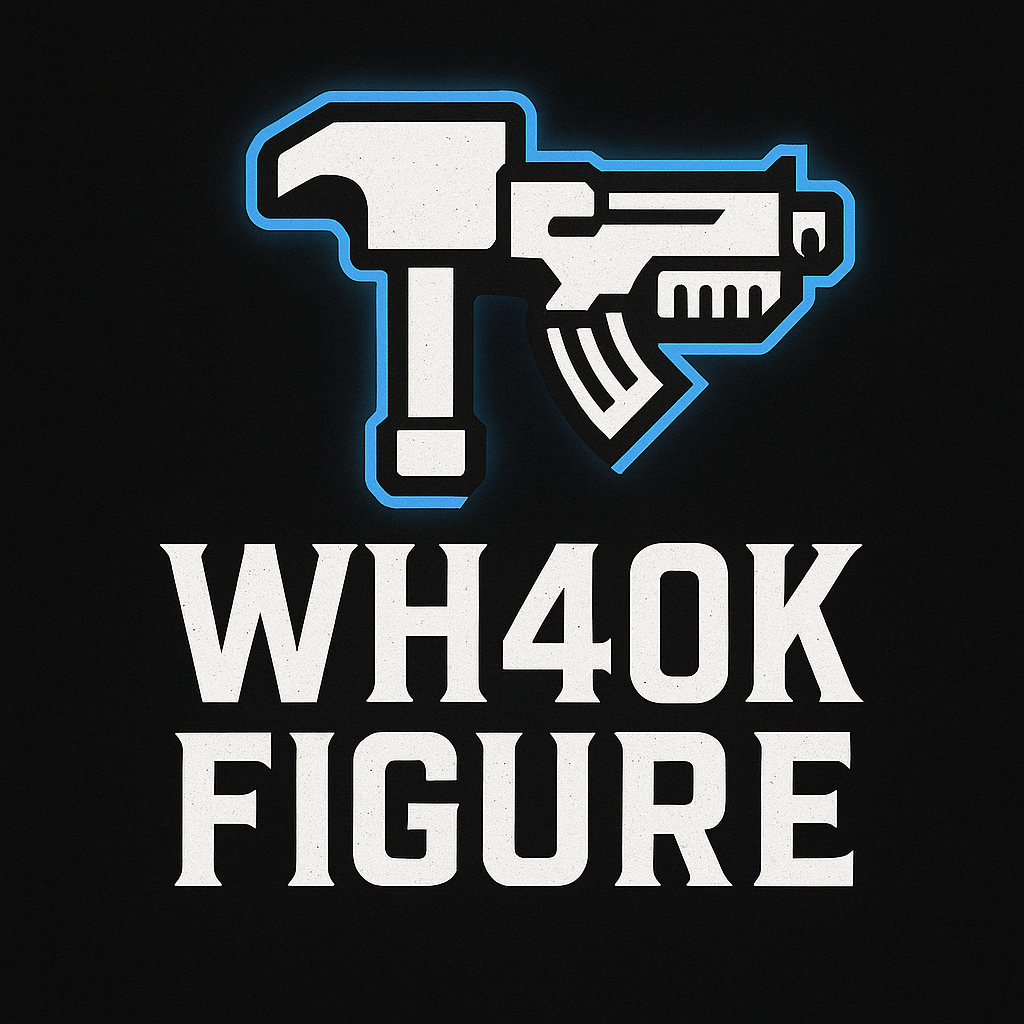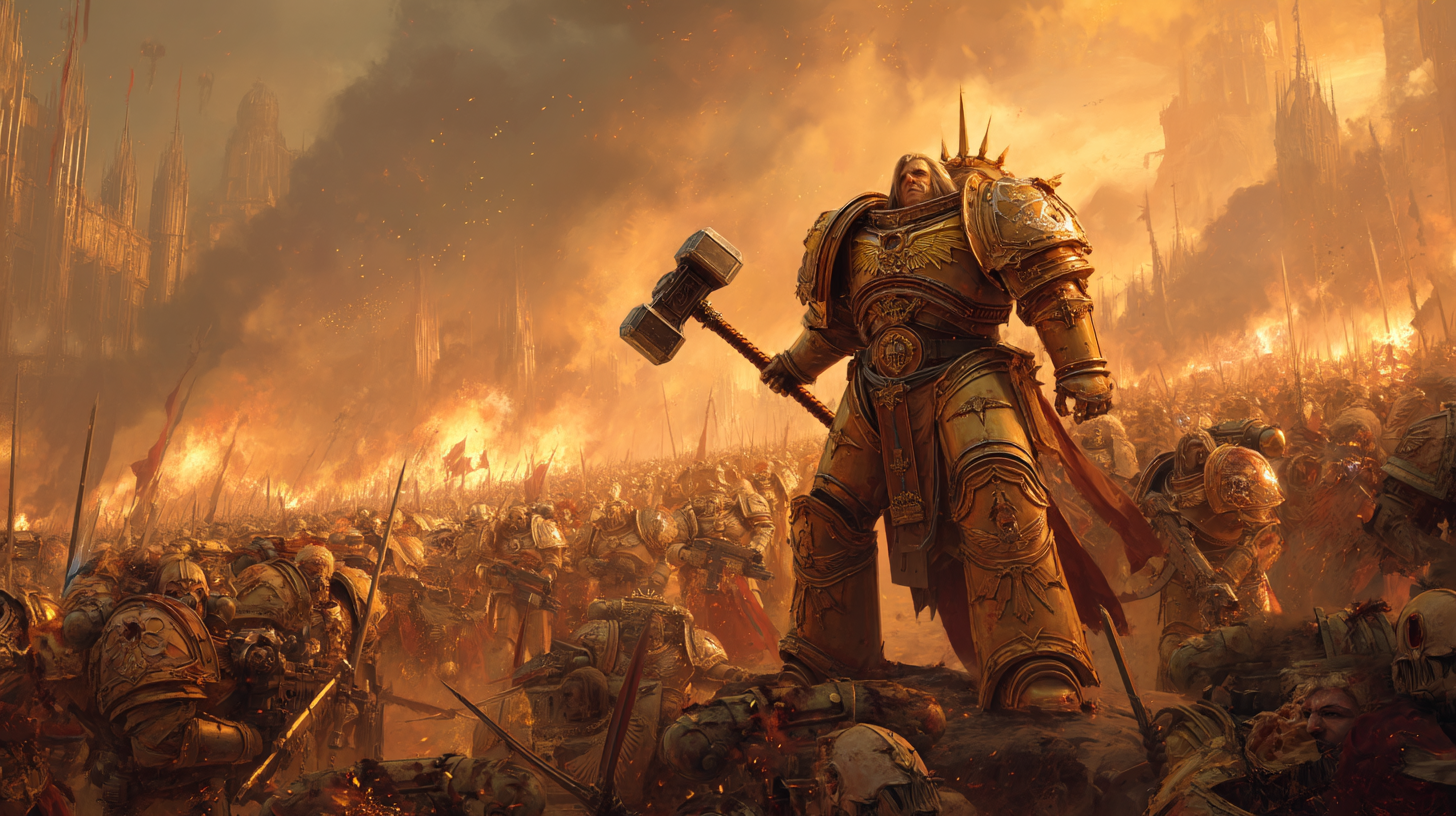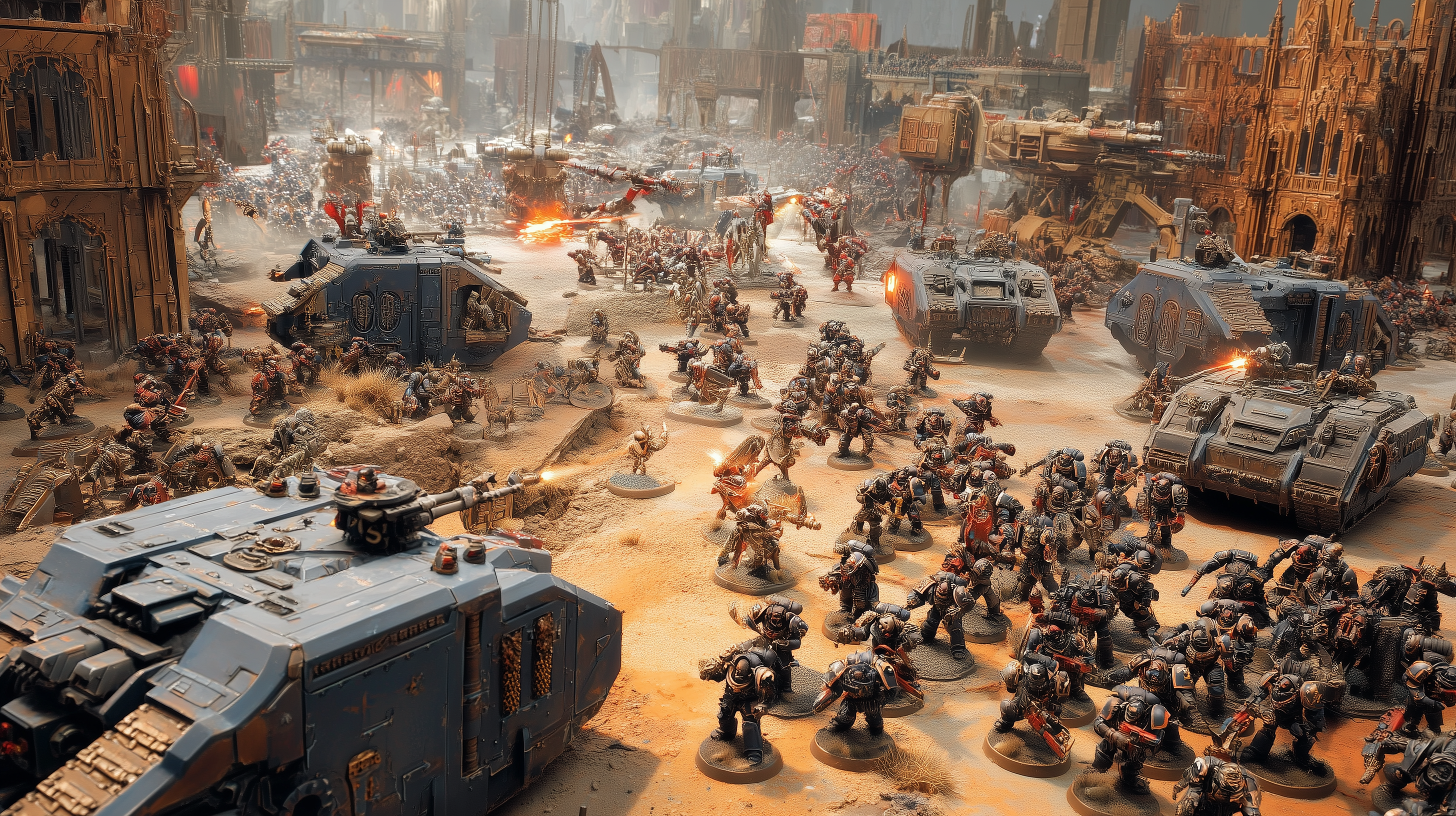You may have seen it in the corner of a comic book store: intricately detailed plastic soldiers locked in eternal combat. You may have heard friends mention rolling dice for a "charge phase" or excitedly discussing something called a "God-Emperor." You might have played a video game like Total War: Warhammer or Darktide and wondered about the impossibly vast universe behind it.
The word is "Warhammer," and it is not just one thing. It’s a hobby, a tabletop game, a series of universes, and a global community all rolled into one. It's a rabbit hole of breathtaking depth, filled with epic stories, stunning artistry, and strategic gameplay. To ask "What is Warhammer?" is like asking "What is science fiction?" or "What is fantasy?" The answer is a sprawling, spectacular tapestry.
This guide is your torchlight in the darkness. We will illuminate the core pillars of Warhammer, explore its two monumental settings, and show you how you can take your very first step into one of the most rewarding hobbies on the planet.
The Three Pillars of the Hobby
At its heart, the Warhammer experience is built upon three interconnected pillars. While you can enjoy any one of them on its own, their true power is revealed when they combine.
1. The Miniatures: The Hobby of Building and Painting
This is the most visible aspect of Warhammer. It all starts with a box of plastic components on a frame, known as a "sprue." Your first task is to become a builder. With a pair of clippers and some plastic glue, you assemble your miniatures. This process is a delight in itself—a tactile, mindful experience of bringing a character or war machine to life from its component parts. From a hulking Space Marine to a chittering Tyranid Hormagaunt, you are the architect of your army.
But building is only the beginning. Next comes painting, and this is where individual creativity truly explodes. Using specially formulated Citadel paints, you transform a grey plastic model into a work of art. You don't need to be a master painter to start. The community is built on the joy of learning, from basic techniques like base coating and washing to advanced skills like edge-highlighting, blending, and weathering.
Your army becomes uniquely yours. Will your Orks have rusty, ramshackle armor? Will your Stormcast Eternals be clad in celestial silver and sapphire blue? Will your Chaos Knights be stained with the blood of their enemies and the corruption of their dark gods? The paintbrush is your tool for storytelling. Seeing a fully painted army that you built and brought to life yourself, arranged for battle, is one of the most satisfying moments in the entire hobby.
2. The Game: The Art of Tabletop Warfare
Once you have your models, you can use them to play the game. Warhammer is a tabletop wargame, a turn-based contest of strategy, tactics, and luck fought on a battlefield of your own creation (often a dining room table with some books and cans for terrain to start!).
The core mechanics are straightforward:
-
Armies: Each player builds an army from a chosen faction, with each miniature ("model") or group of models ("unit") having a profile of stats that dictate how it moves, fights, and defends itself.
-
Movement: You use a measuring tape to move your units across the battlefield, seeking advantageous positions, seizing objectives, or closing in on the enemy.
-
Dice Rolls: The beautiful chaos of battle is simulated with six-sided dice (). Whether you're trying to hit an enemy with a volley of laser fire, manifest a powerful psychic spell, or make a desperate charge, the outcome is determined by dice rolls, modified by your units' skills and the tactical situation.
-
Phases: A player's turn is broken into distinct phases (Movement, Psychic, Shooting, Charging, Fighting), creating a structured and logical flow to the battle.
But beneath this simple framework lies a chasm of strategic depth. Do you sacrifice a fast-moving unit to tie up a powerful enemy cannon? Do you focus your fire on the biggest threat or eliminate smaller units to control objectives? How do you use the terrain to your advantage? Every game tells a story—a saga of heroic last stands, devastating betrayals of luck, and brilliant tactical outmaneuvering.
3. The Lore: The Universes of Endless War
The miniatures and the game are anchored in some of the richest, most detailed, and unapologetically epic settings ever conceived. The "lore" is the collection of stories, histories, and character arcs that give context and weight to every model you build and every dice you roll. This narrative is explored through rulebooks, campaign supplements, and a vast library of novels published by Games Workshop's fiction imprint, Black Library.
Knowing the lore transforms the experience. That's not just a Space Marine Captain; that's Captain Lysander of the Imperial Fists, a legendary hero renowned for his stubborn refusal to yield. That's not just a big monster; that's a Hive Tyrant, a synaptic node-beast of the Great Devourer, a galaxy-consuming swarm intelligent beyond human comprehension. The lore gives your battles meaning and makes your army a part of a living, breathing, and often screaming, universe.
Now, let's explore the two colossal settings that fall under the Warhammer banner.
Two Universes, One Name: 40,000 vs. Age of Sigmar
A newcomer's first point of confusion is often the distinction between the two primary Warhammer systems. They share thematic DNA—grand conflicts, heroic warriors, and malevolent gods—but they are entirely separate universes with their own models, rules, and aesthetics.
-
Warhammer 40,000 (or "40K") is the science-fantasy behemoth. It's a dystopian future set in the 41st Millennium. Think gothic architecture in space, genetically engineered super-soldiers fighting with chainsaw swords, and cosmic horror of an unimaginable scale. Its famous tagline perfectly encapsulates its tone: "In the Grim Darkness of the Far Future, There Is Only War."
-
Warhammer: Age of Sigmar (or "AoS") is the high-fantasy epic. It's a universe of mythological realms connected by celestial pathways, where gods walk among mortals, armies of the dead rise from their graves, and re-forged heroes descend on bolts of lightning to fight demonic legions. It is a world of myth, magic, and cataclysmic battles.
Let's delve deeper into each.
Warhammer 40,000: The Grimdark Future
Imagine a future so dark that the "good guys" are a xenophobic, totalitarian, theocratic empire built on the worship of a corpse-god. That is the Imperium of Man, and it is the crumbling bastion of humanity in a galaxy that wants it dead.
The Setting: Ten thousand years ago, the glorious God-Emperor of Mankind united humanity and launched a Great Crusade to conquer the stars. His genetically-enhanced sons, the twenty Primarchs, led his Space Marine Legions. But a great betrayal, the Horus Heresy, saw his most favored son, Horus, fall to the temptations of the Gods of Chaos. Brother fought brother, and the galaxy burned. The Heresy ended with the Emperor mortally wounded and interred within the Golden Throne—a arcane life-support machine that now serves as a psychic beacon, allowing interstellar travel.
In the "present" day of the 41st Millennium, the Imperium is a decaying, superstitious shadow of its former self. Technology is poorly understood and treated as divine magic. Unspeakable horrors press in from all sides, and the only response is endless, attritional warfare conducted by trillions of soldiers of the Astra Militarum (Imperial Guard), the fanatical battle-nuns of the Adepta Sororitas, and, of course, the iconic Space Marines.
The Factions: The beauty of 40K lies in its diverse and compelling factions, none of which are truly "good."
-
The Imperium of Man: The sprawling, human empire. Its poster boys are the Space Marines (Adeptus Astartes), eight-foot-tall, power-armored super-soldiers who are humanity's finest warriors. Countless "Chapters" exist, each with its own culture and combat doctrine.
-
Chaos: The ultimate antagonist. The Gods of Chaos—Khorne (blood and war), Tzeentch (change and sorcery), Nurgle (plague and decay), and Slaanesh (excess and pleasure)—are powerful entities born from mortal emotion in the parallel dimension of the Warp. Their followers include twisted Chaos Space Marines, grotesque Daemons, and legions of corrupted mortals.
-
Orks: A force of nature as much as a faction. Orks are a fungal warrior race that lives for nothing but the thrill of a good fight (a "WAAAGH!"). They are brutal, cunning in their own way, and provide a dose of dark, violent comedy to the setting. Their technology is ramshackle, held together by their collective psychic belief that it should work.
-
Aeldari (Eldar): The space-elves of 40K. An ancient, dying race whose hubris once created the Chaos God Slaanesh, shattering their empire. Now they navigate the galaxy in giant world-ships, fighting with psychic grace and advanced technology to stave off their inevitable extinction.
-
Tyranids: The ultimate cosmic horror. An extragalactic swarm of bio-engineered monsters, all controlled by a single, terrifying Hive Mind. They do not want to conquer or corrupt; they want to consume. They travel from galaxy to galaxy, stripping every planet of all biological matter to feed their endless hunger.
-
And Many More... The galaxy is also home to the T'au Empire, a young, technologically advanced race fighting for a collectivist "Greater Good"; the Necrons, ancient robotic skeletons rising from their tombs to reclaim their long-lost empire; and the Genestealer Cults, insidious alien infiltrators who undermine planets from within.
40K is a setting of monumental scale and magnificent tragedy. It's about faded glory, the horror of sacrifice, and the slimmest glimmers of hope in an overwhelmingly hostile universe.
Warhammer: Age of Sigmar: The Mortal Realms
If 40K is sci-fi horror, Age of Sigmar is high-fantasy mythology. It rose from the ashes of Warhammer's original fantasy setting (Warhammer Fantasy Battle), which was destroyed in a cataclysmic "End Times."
The Setting: The universe is composed of eight "Mortal Realms," vast planes of existence each tied to a wind of magic (e.g., Ghur, the Realm of Beasts; Chamon, the Realm of Metal; Shyish, the Realm of Death). During the prosperous Age of Myth, these realms were connected and cultivated by a pantheon of gods, including the human God-King Sigmar.
But, just as in 40K, the forces of Chaos found their way in, launching an all-consuming invasion that ushered in the Age of Chaos. The realms were shattered, and hope was all but lost. Sigmar retreated to the celestial Realm of Azyr, sealed its gates, and spent centuries preparing his counter-attack. He gathered the souls of the greatest mortal heroes and, using divine magic, re-forged them into the Stormcast Eternals—immortal, super-human warriors clad in sigmarite armor.
The current era is the Age of Sigmar. Sigmar has unleashed his Stormcast Eternals upon the realms, descending on bolts of lightning to reclaim the land from Chaos and other malevolent forces. It is a time of epic, world-altering battles and nascent empires rising from the ruins.
The Grand Alliances: AoS factions are grouped into four "Grand Alliances," representing their overarching goals.
-
Order: A fragile coalition of "good" and civilizing forces who stand against the tide of darkness. This is the most diverse alliance, led by the golden-armored Stormcast Eternals. They are joined by the steadfast Cities of Sigmar (regular humans, duardin, and aelves), the mysterious and magical Sylvaneth (tree-spirits), the draconic Seraphon (lizardmen from space), and many others.
-
Chaos: The same four Dark Gods from 40K hold sway here, commanding legions of mortals, daemons, and beastmen. Their goal is the complete and utter subjugation of the realms. Factions include the barbarian Slaves to Darkness, the disease-ridden Maggotkin of Nurgle, the frenzied Blades of Khorne, and the reality-bending Disciples of Tzeentch.
-
Death: All who live in the Mortal Realms are destined to one day serve Nagash, the Great Necromancer, the self-proclaimed God of Death. Nagash is a megalomaniacal tyrant who sees all life as a flaw to be corrected. His Soulblight Gravelords command legions of vampires and zombies, while his ethereal Nighthaunt are spectral armies of the damned, and the Ossiarch Bonereapers are a terrifying construct army built from bone.
-
Destruction: The wild, untamable forces that want to tear everything down. Led by the hulking Orruk Warclans, Destruction is a rampaging horde of greenskins, ogors, and gargants (giants). They are not necessarily evil in a cosmic sense; they are a force of pure, anarchic energy that thrives on conflict and smashing things.
Age of Sigmar is a more hopeful and heroic setting than 40K, but no less brutal. It's a world of legendary heroes, terrifying monsters, and battles that can reshape reality itself.
More Than a Game: The Expanded Universe
The Warhammer hobby doesn't stop at the tabletop. It has metastasized into a massive transmedia franchise, offering countless other ways to experience its universes.
-
Video Games: There is a Warhammer game for almost every genre. The Total War: Warhammer series by Creative Assembly is a masterpiece of grand strategy. First-person co-op shooters like Vermintide 2 (AoS) and Darktide (40K) put you directly on the front lines. Action games like Warhammer 40,000: Space Marine and strategy titles like Battlesector and Mechanicus provide hours of entertainment.
-
Books: The Black Library publishes hundreds of novels and short stories. This is where the lore truly comes alive. The Horus Heresy series is a sprawling epic that lays the foundation for 40K. Dan Abnett's Gaunt's Ghosts and Eisenhorn series are considered masterpieces of military sci-fi and noir investigation, respectively. For AoS, books by authors like Josh Reynolds and Guy Haley explore the new frontiers of the Mortal Realms.
-
Animation and Media: Games Workshop's own streaming service, Warhammer+, is producing a growing slate of animated shows that bring the settings to life like never before. The community-created fan film Astartes was so good that its creator was hired by GW, and it serves as a perfect, brutal introduction to the power of a Space Marine.
Your Journey Begins: How to Get Started
Feeling the pull of the grim darkness or the call of the mythic realms? Here is a simple path to begin your own Warhammer journey.
-
Find Your Fascination: What part appeals to you most? The lore? The painting? The game? It's okay to start with just one. Many people in the hobby only collect and paint, never playing a single game. Others are lore experts who listen to audiobooks during their commute.
-
Sci-Fi or Fantasy?: The first big choice. Do you prefer the gothic science-fantasy of 40K or the high-fantasy mythology of Age of Sigmar? Watch some YouTube battle reports, browse the models on the Games Workshop website, and see which aesthetic grabs you.
-
The Rule of Cool - Choose Your Army: This is the most important piece of advice you will ever receive. Do not pick an army because it's considered "powerful" in the current game meta. That will change. Pick the army that you think looks the coolest and has the most interesting story. You will be spending hours building and painting these models, so you need to love them.
-
The Starter Set: Your Gateway: The best value for any new player is a starter set. These boxes typically contain two small armies, the core rulebook, dice, a measuring tool, and everything you need to play your first game. You can split one with a friend or keep both armies for yourself. Sets like Recruit, Elite, and Command for 40K, or Warrior, Harbinger, and Extremis for AoS are designed for this exact purpose.
-
The Hobbyist's Toolkit: To begin building and painting, you only need a few essentials:
-
Plastic Clippers (to remove pieces from the sprue)
-
A Hobby Knife (to clean up mold lines)
-
Plastic Glue
-
A can of spray primer (to help the paint stick)
-
A few basic paints and brushes. Games Workshop sells paint sets tailored to specific factions, which are a great starting point.
-
A Hobby for a Lifetime
Warhammer is more than a product; it's a creative universe. It's the challenge of executing a perfect battle plan. It's the quiet zen of painting a miniature late at night. It's the thrill of reading about a hero's final stand. It's the camaraderie of joining a global community of fellow hobbyists at your local game store or online.
It may seem daunting from the outside, a fortress of complex rules and decades of lore. But at its gate, you'll find a welcoming community eager to share its passion. All it takes to enter is a spark of imagination and a single plastic soldier.
So, pick up a brush. Roll some dice. Open a book. Welcome to Warhammer. The war is endless, but your journey is just beginning.



Laisser un commentaire
Ce site est protégé par hCaptcha, et la Politique de confidentialité et les Conditions de service de hCaptcha s’appliquent.